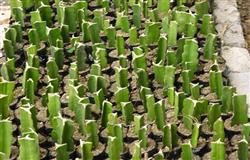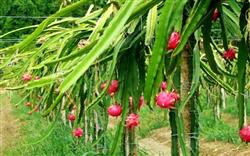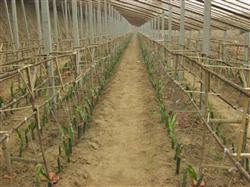Main points of propagation of dragon fruit

The main results are as follows: 1. The cuttings are most suitable in spring and summer. The cuttings should select full stem nodes, which are about 15 cm long. After the wound is air-dried, they are inserted into the sand bed. About 15 Mel can take root in 30 days, and the roots grow to 3 Mel and 4 cm transplantable seedbed. 2. The grafted seedling, which is disease-free, robust and full of stem and flesh, is selected as the rootstock, grafted on a sunny day, and the dragon fruit plant is transversely cut into 4cm stem segments with a knife, waiting for the wound to dry, then cut into a plane with a horizontal knife 10 cm above the stem of the rootstock, insert the scion, align it with the cambium, tie it firmly with cotton thread, and place it in indoor culture. Under the condition of 28Mel 30 ℃, a large number of calli were formed on the wound joint surface of 4Mel in 5 days, and the color of scion was similar to that of rootstock, which indicated that the vascular bundles of them had healed and grafted successfully, and then they could be moved into the pseudo-planting bed to continue to cultivate. (3) the seedling bed for seedling management should choose fields with ventilation and sunny, fertile soil and convenient drainage and irrigation, make a fine border, border ditch 90 cm, apply 1500ml 2000kg of rotten chicken manure or cow manure per mu, mix 1000 kg of grain hull, stir well, and apply to the topsoil layer of 10mur30cm below the border surface during soil preparation. After that, apply 150kg calcium magnesium phosphate fertilizer per mu, stir it fully with a hoe, apply it to the topsoil layer 5cm deep, then plant the seedlings in the seedbed according to the row spacing of 3cm, water thoroughly, and spray 500 times carbendazim once, whiten the topsoil when it is sunny, watering it once as appropriate (about 7MUVE for 10 days), apply 5MUE 7kg compound fertilizer every 10Mul 15 days, wait for a full stem segment of a stem, and then come out of the nursery. As this variety has just entered our country, the cultivation techniques need to be improved. Please explore the experience and explore better cultivation methods.
- Prev

Cultivation techniques and field management of dragon fruit
First, the dragon fruit in the garden is more heat-resistant, water-resistant, like warm, humid, sandy soil rich in organic matter. Before seedling cultivation, according to the specification of 1.5 meters × 2 meters per mu, 110 10 × 10 × 250 cm concrete square columns were erected and 50 cm cement columns were embedded into the soil to support the climbing of dragon fruit branches.
- Next

Key techniques of cultivation and management of dragon fruit in greenhouse
Dragon fruit is also known as red dragon fruit, green dragon fruit, Xianmi fruit and so on. At present, the main cultivated varieties are white dragon fruit, red dragon fruit, yellow dragon fruit. Pitaya is rich in nutrients, mainly containing vitamins, cellulose, glucose, carotene, fat, amino acids and minerals such as phosphorus and iron needed by the human body.
Related
- Moge, come on! The staff of the peasant association in the producing area of cantaloupe were frightened when the crowd gathered.
- Causes and Solutions of low Fruit setting rate of Apple
- Symptoms and control measures of passion fruit virus disease
- Fruit growing lesson: how do apple orchards keep high yields?
- Can you build orchards in the mountains? What are the pros and cons?
- How to manage the coloring period of Crisson grape?
- This paper introduces the processing technology of two kinds of fig products.
- How much is a month for retired teachers in rural areas by 2020?
- How can strawberry planting increase sugar content? We should pay attention to management in many aspects.
- What are the cultivation techniques on how to improve the yield of golden fruit?

